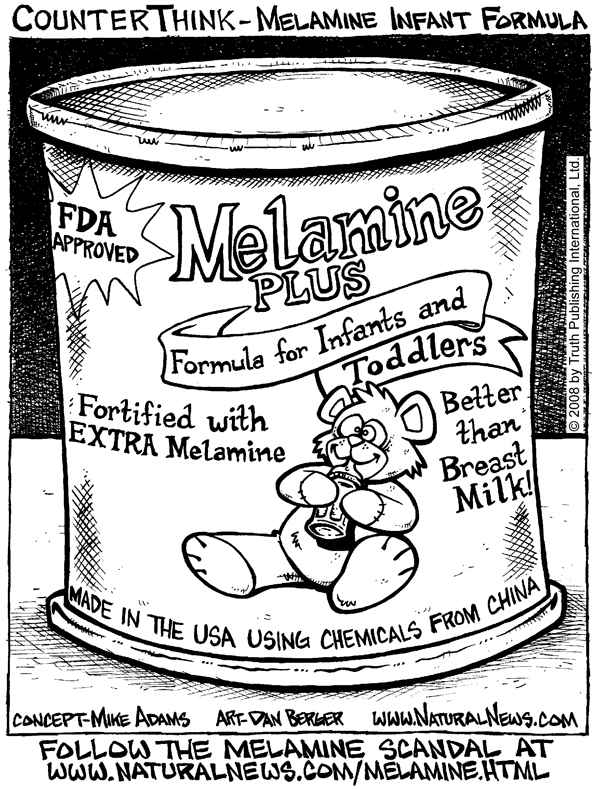 See all CounterThink cartoons...
See all CounterThink cartoons...Comments by Mike Adams, the Health Ranger
(NaturalNews) Following the U.S. Food and Drug Administration's setting of a "safe" level of melamine in foods, the World Health Organization (WHO) has announced its own safety level of 0.2 mg per kilogram of body weight per day.
In other words, the WHO says that a 150-pound person could safely consume 13.6 mg of melamine per day.
That's a lot of melamine. It's almost like a nutritional supplement dose. And the scary part about all this is that
neither the WHO nor the FDA has any science whatsoever to back up this "safe" consumption guideline.
Melamine is an industrial chemical that has sickened hundreds of thousands of children in China and killed babies and pets across the world. It has no place in the food supply whatsoever. For these health agencies that are supposed to be serving the public to now claim that a person can "safely" eat 13.6 mg of melamine per day, every day, is simply outrageous. It is a betrayal of the very public these agencies are supposed to serve and protect.
Without any scientific evidence whatsoever, the world's health agencies are essentially endorsing very high levels of melamine in foods. How high? If a 150-pound person eats just one chocolate bar per day, and that chocolate bar is a 50-gram bar that's contaminated with melamine, the WHO would allow an incredible
272 parts per million of melamine in the bar, which is 272 times the allowable level of melamine contamination that has been put forth by the FDA!
The FDA, you see, is outlining its
melamine limits based on how much melamine is in the food. The WHO, on the other hand, is stating a limit of how much a person can consume, and the WHO limit is significantly higher than what the FDA limit would have typically exposed a person to.
What's really astonishing here, though, is not only that both the
WHO and FDA think it's "safe" for babies, children and adults to consume melamine every day, but that these agencies support the daily consumption of
multiple untested chemicals in combination!
For example, the FDA has declared bisphenol-A to be completely safe and has placed no consumption limit on it whatsoever. There is no limit on acrylamide consumption, either, meaning that a U.S. citizen could be consuming large amounts of melamine, bisphenol-A, acrylamides, phthalates, perchlorates and numerous other chemicals in highly toxic combinations that are all "approved" by the FDA!
I must emphasize
there has been no safety testing done on melamine that could scientifically establish a "safe" consumption limit. Thus, the FDA and WHO are just blindly guessing at what a safe level might be. Consumers are guinea pigs, in other words, and if babies start dying or falling ill from all these chemicals at some later date, then they'll deal with it then (by denying they could have known the chemicals were dangerous, of course).
In other words, the health authorities of the world are now setting
food safety standards in precisely the same way that a fifth-grade takes a history quiz… by
guessing!I have a radical idea: How about setting a standard that would require
no industrial chemicals in the food supply?And why is that so radical anyway? Shouldn't that just be common sense? Why are the FDA and WHO shoving chemicals down our throats and insisting they're all safe to eat?
Why have our food safety agencies become pushers of industrial chemicals?
Permissions to use: Want to use this cartoon? Specific, limited permission is granted to reprint in any book, movie, website, magazine, newspaper, animation or other media under the following 'professional courtesy' conditions:
- Cartoon creator Mike Adams must be conspicuously credited.
- Web address www.NaturalNews.com must be posted below or adjacent to the cartoon in a conspicuous manner. If on the web, the link must be clickable.
- You may not use this cartoon in a disparaging context or manner.
- You may not charge for this cartoon.
- Truth Publishing retains all ownership, rights and copyrights.
- Reprint rights may be revoked, without notice, on a case by case basis, if reprint courtesy is, in our opinion, abused.
High-resolutions files are available for film and print.

